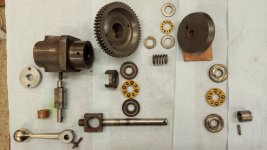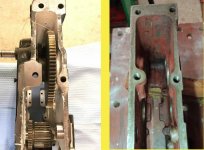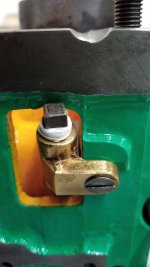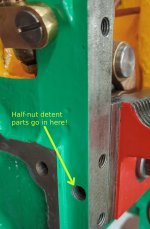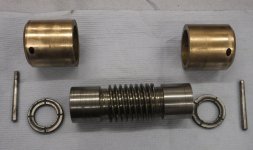CarbideTip
Aluminum
- Joined
- Sep 21, 2016
- Location
- Woking, Surrey, UK.
Replacing the apron internals.
The order in which I took the apron apart wasn’t ideal. So for re-assembly I did some ‘dry runs’ first using dummy ‘bearings’ made from light alloy with clearance (rather than interference) fits. In essence it’s really quite simple. Start at the bottom and work up.
As I had removed the three steel bushings that locate the inboard end of the intermediate gear shafts, these went back first, but only the lowest two should be replaced at this point. When I dismantled the apron I used a depth mike to measure how much each bush was above or below the apron surface. These dimensions help to get the bush back in the same position and it wasn’t that hard to get the threads aligned and the grub screws replaced.

The screws that secure these bushes and shafts are all 3BA x ¼” socket grub and (even in the UK) not as easy to source as they once were. Perhaps because I grew up using BA threads, they always look right to me. In this size metric looks too fine and UNC too coarse. #8 UNF is however pretty close. So close it nearly fits!
3BA is 0.1614” OD x 34.79 tpi (BA threads are defined in metric units) and 47½ degree thread angle!
#8 UNF is 0.164” OD x 36 tpi
First to go back in is the worm-wheel shaft and the sliding gear with two SKF 6204 2Z ball races. These are shielded and identical to those originally fitted.
Next in is the feed reverse shifter fork and it’s control rod. The two aprons I dismantled were different in that the taper pins securing the fork were fitted in opposite directions. If you have to re-ream for an oversize taper pin, make the large end towards the top of the apron.
Then the feed reverse idler and the long compound gear that drives the two feed clutches. All of these gears came from the spare apron as they were in better condition but the shafts are my originals so that the securing grub screws would line up. The shafts are hardened BTW.
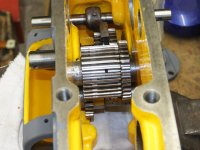
The inner cover can then be fitted, but the cut-out must be at the bottom otherwise the worm won’t fit. The cover screws are 3BA.
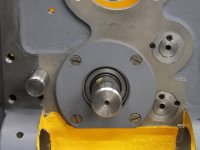
The next shaft to fit is the apron hand-wheel with it’s gear and cam that actuates the oil pump.
The shaft runs on two standard 6203 bearings. I replaced like for like so these are unshielded. The spacer goes nearest the front of the apron.

One difference to the 10EE is that the inner cover does not have a central hole, so the bearing is not exposed and does not need to be shielded.

(for the equivalent 10EE see second picture in Karl Sorensen’s excellent 1942 apron thread: https://www.practicalmachinist.com/forum/threads/42-round-dial-apron-assembly.385782/post-3684021)
The order in which I took the apron apart wasn’t ideal. So for re-assembly I did some ‘dry runs’ first using dummy ‘bearings’ made from light alloy with clearance (rather than interference) fits. In essence it’s really quite simple. Start at the bottom and work up.
As I had removed the three steel bushings that locate the inboard end of the intermediate gear shafts, these went back first, but only the lowest two should be replaced at this point. When I dismantled the apron I used a depth mike to measure how much each bush was above or below the apron surface. These dimensions help to get the bush back in the same position and it wasn’t that hard to get the threads aligned and the grub screws replaced.

The screws that secure these bushes and shafts are all 3BA x ¼” socket grub and (even in the UK) not as easy to source as they once were. Perhaps because I grew up using BA threads, they always look right to me. In this size metric looks too fine and UNC too coarse. #8 UNF is however pretty close. So close it nearly fits!
3BA is 0.1614” OD x 34.79 tpi (BA threads are defined in metric units) and 47½ degree thread angle!
#8 UNF is 0.164” OD x 36 tpi
First to go back in is the worm-wheel shaft and the sliding gear with two SKF 6204 2Z ball races. These are shielded and identical to those originally fitted.
Next in is the feed reverse shifter fork and it’s control rod. The two aprons I dismantled were different in that the taper pins securing the fork were fitted in opposite directions. If you have to re-ream for an oversize taper pin, make the large end towards the top of the apron.
Then the feed reverse idler and the long compound gear that drives the two feed clutches. All of these gears came from the spare apron as they were in better condition but the shafts are my originals so that the securing grub screws would line up. The shafts are hardened BTW.

The inner cover can then be fitted, but the cut-out must be at the bottom otherwise the worm won’t fit. The cover screws are 3BA.

The next shaft to fit is the apron hand-wheel with it’s gear and cam that actuates the oil pump.
The shaft runs on two standard 6203 bearings. I replaced like for like so these are unshielded. The spacer goes nearest the front of the apron.

One difference to the 10EE is that the inner cover does not have a central hole, so the bearing is not exposed and does not need to be shielded.

(for the equivalent 10EE see second picture in Karl Sorensen’s excellent 1942 apron thread: https://www.practicalmachinist.com/forum/threads/42-round-dial-apron-assembly.385782/post-3684021)


